
Feature Article
Paying Extra Attention to Food Safety in Commercial Kitchens in the Post-pandemic Era
With the lifting of COVID-19 restrictions, more customers are returning to dine-in restaurants. In the post-pandemic period, the shortage of experienced workers has made food safety more essential for food premises. Unlike home kitchens (where usually only one person prepares the food for a family), commercial kitchens may have many food handlers (such as chefs, kitchen helpers and waiters) working together to cater for a large number of people. To prevent food poisoning, commercial kitchens must be well managed to ensure adherence to food safety requirements.
Well-Prepared for Resumption of Normal Business?
The major causes of the recent food poisoning cases involving restaurants were consumption of raw food, inadequate cooking, time and temperature abuse, and cross-contamination (including food to food, equipment to food, and person to food). The above problems can be avoided with appropriate food safety training that improves the knowledge, attitudes and practices of food handlers.
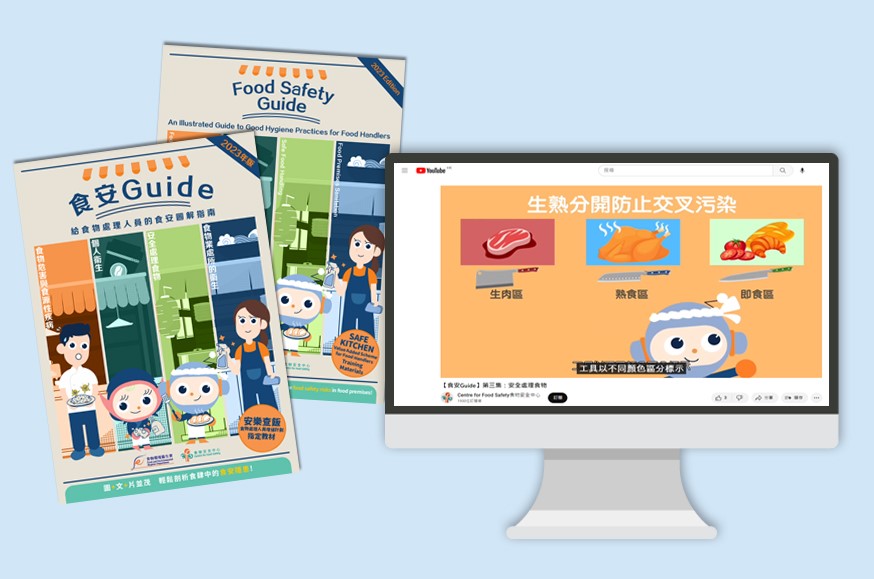
The "Safe Kitchen" website of the Centre for Food Safety aims to update food handlers' knowledge and protect consumers' health.
Training is Key to Food Safety
Some food business operators (FBOs) still view food safety as nothing more than common sense, as evidenced by their food safety training practices. However, a common sense approach alone is insufficient when it comes to serving food to the general public. Survey findings shows that good hygiene is at present more of a factor in choosing a restaurant by customers than before the COVID-19 pandemic. Adhering to Good Hygiene Practices (GHPs) can protect customers from food hazards, including chemicals, broken glass, plastic fragments, insects, germs, toxins, etc.. GHPs refer to fundamental measures and conditions applied at all steps along the food chain to provide safe and wholesome food. For example, food businesses need to make sure their premises (especially kitchens, utensils and food contact equipment) are clean, and have pest control and proper waste disposal in place. Food handlers should wash their hands before handling food, wear disposable gloves when handling ready-to-eat food, wear clean clothing, and follow the Five Keys to Food Safety when working. They should refrain from handling food if they are sick. It is critical that food handlers receive suitable training in order to improve food safety and bring long-term benefits to the catering industry. All food handlers, whether full-time, part-time or temporary, should receive food hygiene training that suits their operational needs.
In addition, regular retraining should be provided for food handlers to reinforce their hygienic habits and give them more chances to learn and practice new skills. FBOs may provide food safety training to staff at least once a year. Hygiene managers should also recognise the importance of regular checking on their food handlers for safeguarding food safety.
Well-organised Kitchen, Lower Risk
Among various risk factors, cross-contamination may be especially hard for local restaurants to deal with. Given the need to prepare a wide variety of dishes in a limited space, FBOs should carefully consider their kitchen setting and its cleaning to prevent cross-contamination. Commercial kitchens should use separate refrigerators for storing raw food and cooked food or ready-to-eat food. Worktop areas also need to be designed to follow the pattern of preparation, from cooking to plating up. When preparing raw foods, dedicated cutting boards and utensils should be used and separate from cooked foodstuffs. Kitchen sinks must never be fitted in an area where contaminated water may splash on clean utensils, food or food preparation areas. In tight areas, a barrier may need to be installed between the sink and the worktop area. Cutting boards and utensils must go straight into the wash, and worktops must be thoroughly wiped and cleansed before the preparation of the next dish. All rubbish bins must have covers and garbage should be disposed of on a daily basis.
Food businesses should pay attention to possible food contamination by food handlers and the environment. Posters or stickers, etc. can be posted on the walls of toilets and kitchens to remind staff about good hand hygiene and the correct ways of food preparation. In addition, frequent and regular cleaning, sanitising, and repair and maintenance of floors, walls, ceilings and equipment are necessary for the removal of food contaminants. Food businesses should have a schedule which lists the items that require regular cleaning.
To facilitate the trade's adherence to GHPs and promote on-the-job training, the Centre of Food Safety (CFS) has launched a new thematic website called “Safe Kitchen” , where various educational materials including handbooks, short videos, cues, etc. are available. FBOs may wish to encourage staff to browse the website.
"Safe Kitchen":

Mascot ON in Lesson
Commencement of Harmful Substances in Food (Amendment) Regulation 2021 in Phases in 2023
The Harmful Substances in Food (Amendment) Regulation 2021 (the Amendment Regulation) was passed in July 2021. It aims to tighten the regulatory control of mycotoxins in food, as well as setting or updating maximum levels for other harmful substances in edible fats and oils, condiments, or formula products intended for infants. Based on the recommendation of the World Health Organization (WHO), the Amendment Regulation also lists partially hydrogenated oil (PHO), the main source of industrially produced trans fatty acids (IP-TFAs), as a prohibited substance in food. Such an amendment serves to eliminate IP-TFAs at source to protect public health.
The provisions stipulating the maximum levels of mycotoxins and other harmful substances in food came into force on 1 June 2023, while those on prohibiting PHO and the associated labelling requirements will take effect on 1 December 2023. The trade should ensure food sold compiles with the legislation. Food industries should produce healthier food by reducing trans fats and replacing IP-TFAs and consumers should maintain a balanced diet comprising a wide variety of fruits and vegetables.
Relevant provisions of the Amendment Regulation:

Spot Check
Iodine in Food
Iodine is an essential micronutrient required for normal thyroid function, growth and development. The WHO recommends a daily iodine intake of 150μg for adolescents and adults.
Advice to the Public
(1) Consume Foods High in Iodine
The public is advised to consume iodine-rich foods as part of a balanced diet. Seaweed, kelp, shellfish, marine fish, eggs, milk and dairy products are rich in iodine.
|
Iodine content of some iodine-rich foods (μg/kg)1: |
|
|
Dried kelp and laver |
8 900 – 2 600 000 |
|
Seaweed snack and nori sheet for sushi |
6 400 – 38 000 |
|
Shellfish and marine water fish |
32 – 2 100 |
|
Eggs |
82 – 2 300 |
|
Dairy products |
40 – 1 400 |
1 Risk Assessment Studies Report No. 45 — Dietary Iodine Intake in Hong Kong Adults, CFS, Food and Environmental Hygiene Department (2011).
Iodine may dissolve in water during cooking. To retain its maximum amount, try to steam, or stir-fry foods with little oil, and cook clean crustaceans intact.
(2) Use of Iodised Salt in the Diet
What is iodised salt?
Iodised salt is salt that has been iodised or "fortified" with iodine.
How can consumers tell if the salt is iodised or not?
Many brands of salts have iodised and non-iodised counterparts. Check their food labels (e.g. the brand name and the ingredient list) for any indication of iodine being added, such as the words "iodi-" (e.g. iodised, iodized, iodide, iodine), "ioda-" (e.g. iodated, iodate), "laver", "alga", "kelp", "seaweed", etc.
What to note when using iodised salt?
- Keep the overall salt intake (including iodised and non-iodised salt) to below 5g (1 teaspoon) per day.
- Store iodised salt in a tight, coloured container and keep in a cool, dry place to minimise its iodine loss due to humidity, heat or sunlight.
- Add iodised salt to food as close to the time of serving as possible, in particular for prolonged boiling and pressure cooking. This can minimise iodine loss through the cooking process.
A note of caution:
Persons with thyroid problems should seek medical advice regarding the use of iodised salt.
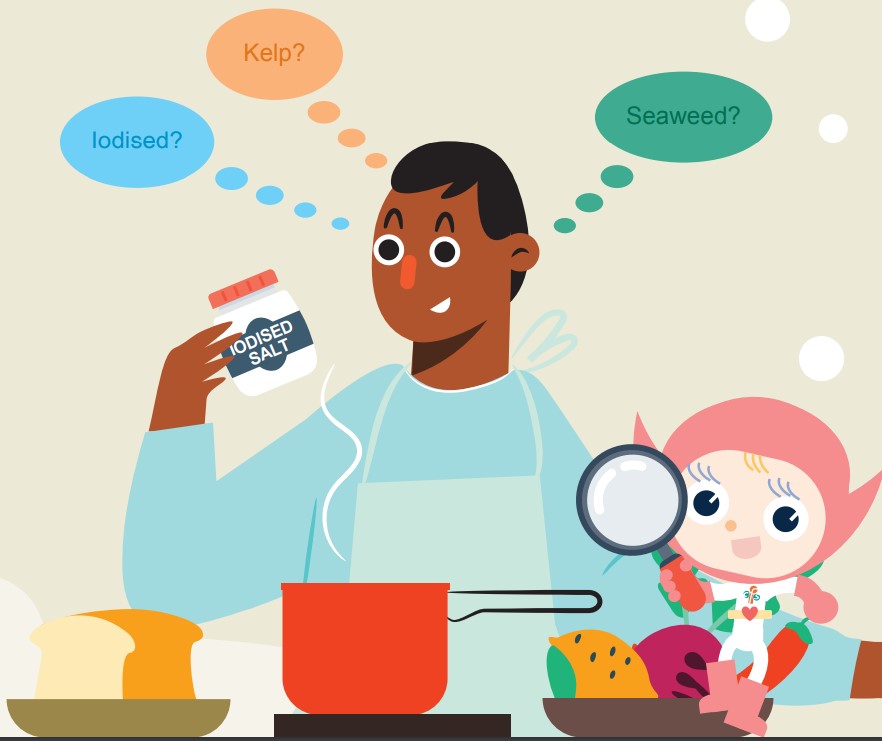
Microbiological Quality of Ready-to-eat Food Sold by Vending Machine
In recent years, in addition to selling prepackaged food, certain new types of vending machines also sell food that has undergone simple processing inside the machine. Regarding their operation, special attention should be paid to issues such as temperature control and cleaning to ensure food hygiene and safety. The CFS has conducted a study on the microbiological quality of ready-to-eat food sold by vending machine.
Among the 74 food samples collected from such vending machines, none of them were detected with foodborne pathogens. As for the indicator of quality, most samples (89%) were satisfactory in terms of the results of the aerobic colony count (ACC) except eight samples (11%) with ACC at borderline levels. This may be due to the quality of ingredients used, or contamination during the mixing of the ingredients or dispensing of the products inside the vending machines. By making reference to the guidelines of the CFS, the food trade should handle the ingredients properly, maintain right storing temperatures, and clean the vending machines regularly and when necessary.
Safe Kitchen/Trade Talks/Food Safety Guidelines
Safe Kitchen
Introduction to "Safe Kitchen" Scheme
To facilitate the adoption of the Five Keys to Food Safety and GHPs by trade members, and enhance food safety in their daily operation, the CFS has integrated the existing channels of risk communication and launched a new platform, namely "Safe Kitchen", to communicate with the trade. The platform provides food safety information of greater practical importance to meet the operational needs of catering outlets.
The "Safe Kitchen" platform disseminates up-to-date food safety information (including food safety guidelines and relevant legislative amendments) to the trade through a host of channels including WhatsApp, emails and dedicated websites. In response to food poisoning outbreaks in restaurants, the platform will also issue food alerts to remind the trade of the points to note in preventing future occurrences so that the risk of food poisoning can be minimised.
New dedicated websites and risk information exchange platforms will be rolled out under the "Safe Kitchen" Scheme. In addition, training materials tailor-made for the trade and workshops for kitchen staff will be provided to enhance food safety and hygiene awareness among them. Members of the trade are welcome to scan the QR code at the side to download the registration form for the "Safe Kitchen" Scheme in order to receive the latest food safety information in a timely manner.

Food Safety Guidelines
Cooling and Reheating Prepared Foods — Food Safety Guidelines for Food Businesses
Most of us know that prepared food that will not be eaten right away should be cooled as soon as possible, stored at the right temperature, and reheated thoroughly before consumption. In addition, prepared food should not be left at room temperature for too long.
- But why should we cool hot cooked food?
- Why should we hurry to cool food if we can reheat it later to kill germs?
- How to cool and reheat food correctly?
If the above questions bother you, and you want to find out the answers and the food safety concept behind, you could refer to the "Cooling and Reheating Prepared Foods — Food Safety Guidelines for Food Businesses" published by the CFS recently.

Salt Iodisation — A Practical Guide for Salt Importers, Wholesalers and Retailers
Iodine is an essential micronutrient required for thyroid hormone synthesis to support growth and development. Persistently low iodine intake will result in iodine deficiency or even damage to the developing brain and other harmful effects known collectively as iodine deficiency disorders. The best way of preventing micronutrient malnutrition is to maintain a balanced diet that is adequate in every nutrient.
Currently, iodised salt (i.e. salt iodised or "fortified" with iodine) is not yet widely available in Hong Kong. In view of this, with reference to the WHO's and Codex's guidelines and/or standards relevant to iodised salt, the CFS has produced "Salt Iodisation — A Practical Guide for Salt Importers, Wholesalers and Retailers" to encourage food traders to make iodised salt more accessible to the local population. For details, please visit the following homepage or scan the QR code at the side.

https://www.cfs.gov.hk/english/programme/programme_fii/files/Food_Iodisation_e.pdf
News on CFS
1. The 53rd Session of the Codex Committee on Food Additives (2023)
The 53rd Session of the Codex Committee on Food Additives, which took place from 24 to 31 March 2023 at the Regal Airport Hotel, was chaired by China as the host country with the CFS assisting in its organisation. Mr Lei Haichao, Vice Minister of the National Health Commission, was one of the officiating guests, and the event was attended by about 220 representatives from 51 member countries and one member organisation (the European Union) as well as 25 international organisations worldwide. Translation services in four international languages (Chinese, English, French and German) were available, and the session was broadcast live online worldwide.
Moreover, to coincide with the 60th anniversary of the establishment of Codex, celebration events were organised by the CFS specially for the participants from all over the world so that they could learn more about China and Hong Kong despite the busy schedule.

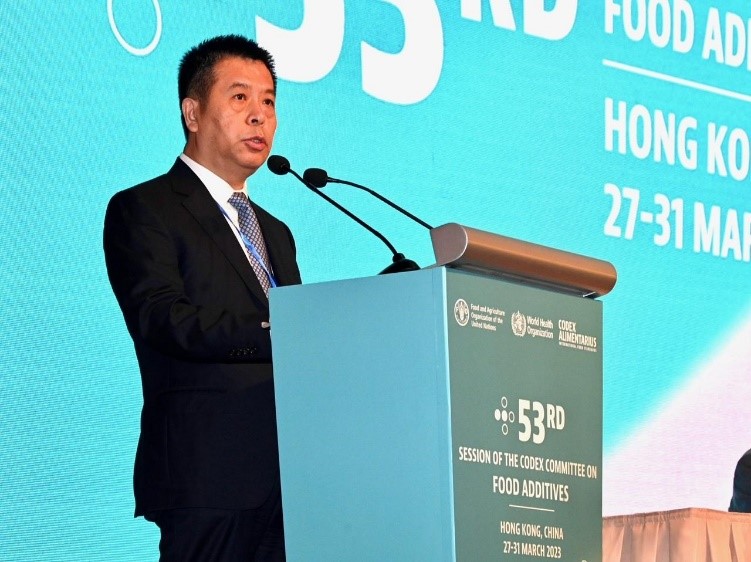
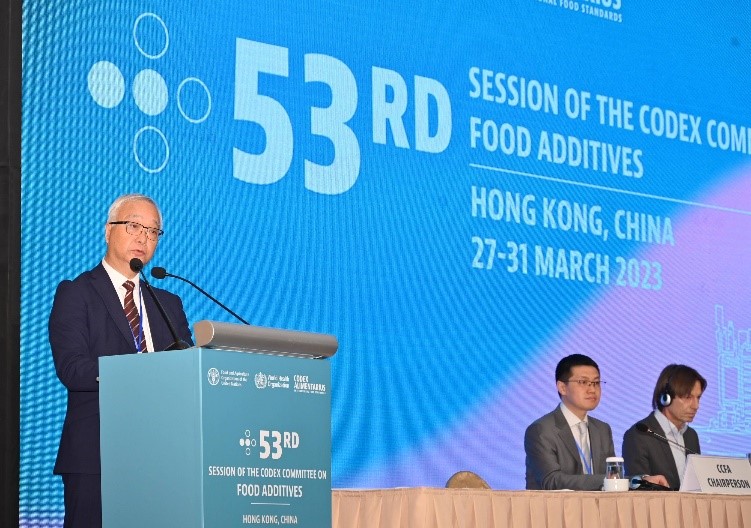
2."Post-COVID-19 Food Safety: Antimicrobial Resistance and Practising Good Hygiene Practices" Webinar Organised by CFS
The CFS implements a routine surveillance programme on antimicrobial resistance (AMR) in raw meat and ready-to-eat food on sale in Hong Kong. In view of the recent surveillance results, the CFS specially urges food businesses to stay vigilant about food safety and follow the Five Keys to Food Safety to prevent the risks of food poisoning and AMR in food. Inappropriate food handling encourages the spread of AMR bacteria, while inadequate knowledge and training among food handlers poses potential threat to food safety. To enhance food safety education, the CFS held four webinars for the trade on "Antimicrobial Resistance and Practising Good Hygiene Practices" starting from mid-April.
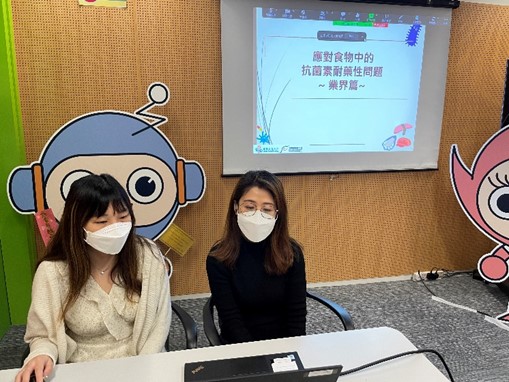
3. The 80th Meeting of the Trade Consultation Forum
The 80th meeting of the Trade Consultation Forum, in physical form, was held on 27 April 2023. The CFS and the trade exchanged their views on topics including "Guidelines on Food Safety and Hygiene for Vending Industry", "How to Address Antimicrobial Resistance (AMR) in Food", "Food Labelling and Nutrition Labelling of Prepackaged Food", "New Arrangement for Extension of Fresh Food Imported via Hong Kong-Zhuhai-Macao Bridge" and "Commencement of Expedited Processing of Import Licence Applications for Frozen Meat and Poultry". For details, please visit:
https://www.cfs.gov.hk/english/committee/Notes_and_Presentation_Materials_TCF80_20230427.html



4. CFS Joined "Tsuen Wan District Weekend Bazaar"
The CFS took part in the "Tsuen Wan District Weekend Bazaar" organised by the Tsuen Wan District Environmental Hygiene Office of the Food and Environmental Hygiene Department at Sha Tsui Road Playground over the three-day long weekend from 26 to 28 May. Video clips on food safety were played from a broadcasting van set up by the CFS in the bazaar. There were also booths set up by other government departments (including the Police and the Fire Services Department) for distributing publicity materials and giving information relating to the departments to the public. Moreover, as well as 60 booths selling a diverse range of commodities, there were various booth games and stage performances, making the bustling bazaar a fun-filled occasion for the public.




5. Public Consultation Forum on Proposed Amendments to Preservatives in Food Regulation (Cap. 132BD)
The Government has launched a public consultation exercise on the proposed amendments to the Preservatives in Food Regulation (Cap 132BD) (the Regulation). It will last for three months until 28 August 2023. To this end, the CFS held the first public consultation forum on 9 June 2023, where the participants enthusiastically shared their opinions and asked questions about the proposed amendments.
Members of the public are welcome to express their views on the proposed amendments during the consultation period. The consultation document is available for download on the CFS's website:
https://www.cfs.gov.hk/english/whatsnew/whatsnew_fstr/whatsnew_fstr_Proposed_Amendments_Preservatives_Food_Regulation.html


Ask Our Mascots
How to Interpret the Test Report on Goji Berries
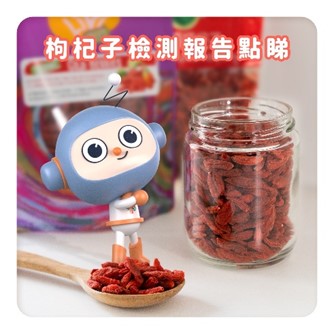
An organisation collected 27 dried goji berry samples on the market for food safety and nutrient content tests. According to the test report, metallic contaminants, pesticide residues, etc. were found in some samples.
Listen To Our Mascots:
- Metal naturally exist in the environment. Despite the traces of metallic contaminants detected in some goji berry samples, all test results complied with the requirements of the local laws, the Codex and the Pharmacopeia of the People's Republic of China.
- For the two products with lead concentration close to the legal limit, the CFS promptly collected samples of the same type of products for laboratory tests. After applying the conversion factor, the test results were satisfactory (0.01 mg/kg of lead in food for one sample and no lead was detected in another sample).
- For the goji berry products with traces of pesticide residues detected, the risk assessment of the CFS revealed that all samples met the legal requirements as they would not be detrimental to health upon normal consumption.
- Taking the two pesticides (i.e. chlorfenapyr and chlorothalonil) mentioned in the test report as examples, the public would have to consume over 29 kg and 16 kg of the relevant goji berry products per day respectively to pose a health risk.
A Reminder On Food Safety:
- consumers should patronise reputable shops and avoid goji berries with abnormally intense colour and sold at an excessively low price.
- choose goji berry products with intact packaging as far as possible because their quality is more stable and they are less prone to be spoiled, attacked by insects, contaminated or dampened.
- dried goji berries should be stored in a clean airtight container and kept in a cool, well-ventilated and dry place.
- soaked goji berries should be used as soon as possible to avoid the growth of bacteria.
Food Safety Quiz
-
Given that bakery products are usually made with ingredients containing partially hydrogenated oils, what is/are the health effect(s) of excessive consumption of such products?
- Loss of weight
- Increased risk of coronary heart disease
- Healthier heart
- Increased bone density
- To avoid purchasing goji berries with excessive metallic contaminants and pesticide residues, members of the public should:
-
Patronise reputable shops
- Avoid goji berries with abnormally intense colour and sold at an excessively low pricE
- Choose goji berry products with intact packaging as far as possible
- All of the above
-
- Which session of the Codex Committee on Food Additives was held in Hong Kong in 2023?
-
53rd
-
55th
-
60th
- 65th
-
Answers:
- b
- d
- a
Diary of Mascot ON
Risky Food Across the Border
Is there any "germ-free dimension" in the world of games? The real world, however, is filled with invisible bacteria that are ready to multiply in food given the right temperature and time.
- High Risky Cross-border food delivery
Recently, there have been reports of cross-border group purchase services for food. Could it be… the K of Hearts? Or the K of Diamonds? Actually, it's NOT OK!!!
- Hard to control the temperature during delivery
Even if hygiene standards are met during the production process, any improper control of temperature during the lengthy delivery process may expose the food to the dangerous temperature zone for an extended period of time, which will give bacteria the opportunity to grow and cause a food safety crisis.
- Keep hot food hot and cold food cold
After preparation, cold food should be kept at 4℃ or below while hot food at temperatures over 60℃. Delivery should be made with a clean insulated device as soon as possible. As a glutton, do you really want to take the risk of food poisoning by using cross-border food delivery services for convenience? No way! It's too dangerous!
